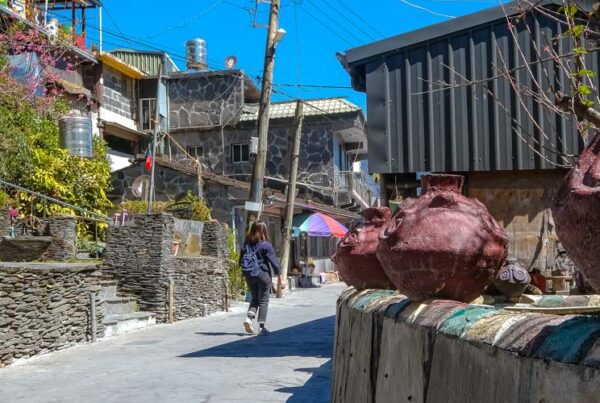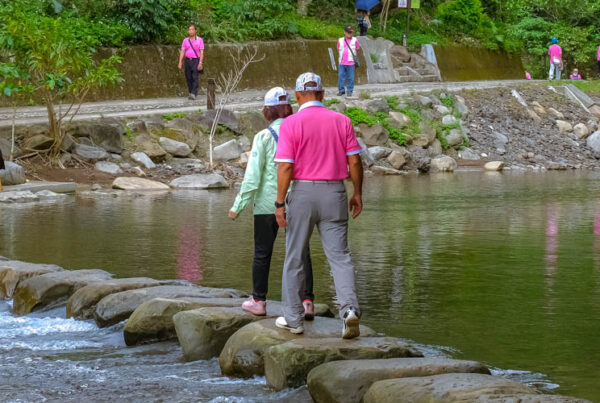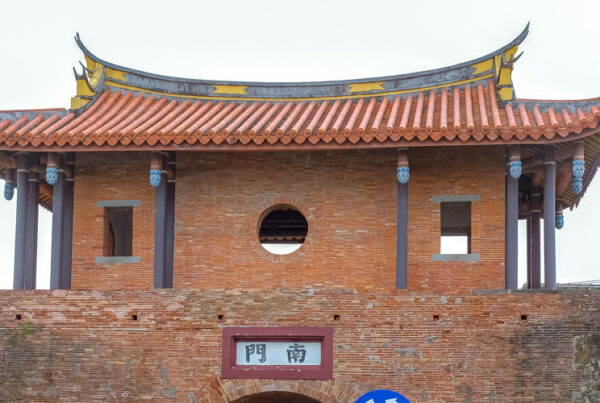A Southern Taiwan Sleepover with Belugas and Other Sea Creatures
TEXT / HAN CHEUNG
PHOTOS / LOUIS LIU
If you have ever felt that a visit to an oceanographic museum was too short and wished you could stay a little bit longer to admire the wonders of the marine world, you might consider signing up for the National Museum of Marine Biology and Aquarium’s overnight stay option. This is great fun for the whole family, and can be paired with spending time at other tourist hotspots in the same area’s Kenting National Park.
You’ll never see your kids as eager to make their beds and tuck themselves in as when they participate in the National Museum of Marine Biology and Aquarium’s (NMMBA) sleepover program (www.aquarium.com.tw; Chinese). Even a night owl like me was in bed by 10pm, glasses still on so I could stare at the belugas, Angel and Jingbao, drifting back and forth before me in slow motion. I then woke up in the middle of the night to the sound of the whales making high-pitched chirps at each other, the signature sound of belugas that has earned them the nickname “canaries of the sea.” I pulled my blanket tighter, and contentedly drifted back to sleep.

The beluga pool area is just one of several areas available as part of the aquarium’s overnight program. Those who need a serious break from the sweltering Taiwan summers can also nap at the penguin hall, which is cooler than the rest of the museum, and the bustling amphitheater area with the dog sharks and manta rays is also quite mesmerizing. For a different kind of adventure, there’s also a faux-sunken-ship area where the walls and ceiling are meticulously modeled to look like they have been underwater for decades. The most picture-worthy option of all, however, is the 80m underwater glass tunnel – one of the longest in Asia – where visitors are bathed in the blue light as if they were in the water alongside the myriad sea creatures. If interested in the sleepover program, check which areas are open and register early, as the earliest to sign up get first dibs.

The program, which includes guided tours and craft activities, is ideal for school trips and family fun. For us adults, it’s one of those things we wish we had done as a kid but never had the chance to. The museum is located north of the picturesque bay at the village of Houwan, made famous by the 2008 hit Taiwan movie Cape No. 7, and the sleepover experience can be part of a bigger excursion that includes the tropical paradise that is Kenting National Park (www.ktnp.gov.tw). The museum is situated in the northwest corner of the park, which from there stretches all the way down to the island of Taiwan’s southernmost point, covering all of the coastal areas and much of the hinterland in this area.

Opened to the public in 2000, the NMMBA (www.nmmba.gov.tw) occupies 35.81 hectares, and has three major exhibition areas: Waters of Taiwan, Coral Kingdom Pavilion, and Waters of the World. It also has a marine station and two research buildings dedicated to the conservation of coral reefs in the national park. Its many achievements include becoming the first institution in the world to breed ringed pipefish successfully in captivity, in 2014, and it is one of 38 attractions to receive three stars in the latest Michelin Green Guide Taiwan.

Part of the sleepover program is an exploration of the Houwan area, including a bit of sea kayaking. After arriving at the museum early in the afternoon, we – a couple of friends and I – headed to Houwan, a sleepy fishing village that can be reached on foot from the museum by traversing a sandy beach scattered with coral rocks. The beach faces the beautiful half-moon-shaped bay. Tourists are drawn to this village, and there are a number of themed guesthouses along the waterfront – but overall it still retains the charm that made it one of the shooting locations for Taiwan’s highest-grossing domestic film ever.

All four of the types of hermit crab that inhabit Taiwan make their home at Houwan, and there are “shell recycle stations” along the village’s boardwalk, reminding people not to take away any potential homes for the crustaceans. In 2017, Houwan became the first community in Kenting National Park allowed to offer kayaking and stand-up paddleboard activities, as it was deemed that such activities would not negatively affect the local ecosystem. The local development association also offers sea-salt tofu-making workshops, and eco-tours of the surrounding terrain.
The waves were strong on the day of our visit, but we went out on a short kayaking excursion anyway, aiming to make a straight line back across the bay toward the museum. Sea kayaking is harder than it seems, but it was great fun to ride the waves and try to remain on course. It was a Thursday, and I was struck how tranquil this place was compared to more popular spots further south along the coast. It’s impossible to stay dry doing sea kayaking, so bringing a change of clothes is recommended.

Back at the museum, we showered and changed. The spacious facilities include thoughtful features such as clothing dehydrators and lockable phone-charging stations. There’s no need to bring food – the overnight stay includes a buffet dinner and breakfast, and along the terrace that connects the buildings vendors hawk Turkish-style ice cream, hot dogs, and other snacks during the day. The museum management has seen to it that nobody will go hungry – they even serve guests a late-night sweet mung-bean soup, and if that still isn’t enough, the basement has instant-noodle vending machines.
The overnight visitors were split into different groups, to each of which was assigned a guide named after a sea creature. Ours was Sister Anemone, a highly spirited and knowledgeable young lady from Hualien County in eastern Taiwan who had done extra homework upon learning she would be guiding us foreigners, memorizing the English names and nicknames of the creatures she would be showing us on our tour.

After walking us through the fascinating Waters of the World exhibit, our guide took us behind the scenes, above the massive tanks where the keepers descend into the water to feed the marine denizens. We got to see tanks of baby clownfish, seahorses, and other recent arrivals still acclimating to their life in captivity, not yet ready to join the larger underwater community below.


We learned about the divers’ equipment, and why some helmets are adorned with fake clownfish (to protect the divers from “attacks” by hungry fish, and to make certain fish feel more at ease), touched the leathery collagen egg cases of dogsharks, and learned about the contents of the freezer full of fish used to feed larger animals.
After dinner, we met up with Sister Anemone again for a tour through the Coral Kingdom, which is designed on a slope to mimic visitors slowly descending into the ocean. This time, our guide explained how fish sleep, showed us nocturnal species that remain in hiding during the day, and also explained how many sea creatures have fluorescent qualities. It’s an ethereal journey that’s substantially different from regular visits during the day, eerie yet magical at the same time. When we passed through the glass tunnel, it became obvious why everyone wanted to sleep here despite the somewhat limited space. We were literally surrounded by swimming creatures that passed over in schools or solitarily, creating a kaleidoscopic feast for the senses.

Exiting the tunnel, we met our companions for the night, the resident belugas, which we learned to recognize through their skin markings, genitalia, and other characteristics. They have the intelligence of a 7-year-old, explained our guide; Angel is the most playful, and will visibly respond to visitors and follow them across the room, while Jingbao by comparison is more reserved. They’re majestic creatures that are a wonder to watch, but the reality is also that they were made to perform for humans until, around the globe during the past decade, such practices came to be considered inhumane and became outdated. After seven of the museum’s original 10 belugas died due to various causes, it was announced last December that belugas would no longer be imported or bred, making the current three the last of their kind in Taiwan.

After our tour, we went to a DIY room to make sea creatures from clay. Don’t dismiss this as a kiddie activity; it can be rather therapeutic for adults too. Afterwards, the time soon came to make our beds.

The lights are turned out at 10pm, although the restless can still wander the museum, or go outside and look at a full sky of stars until the building is closed at midnight. I was afraid the children would be loud, but they all seemed mesmerized into silence by what they saw above and around them in the water.
The next day a different guide took us back to Houwan’s coral beach to examine the marine life in the intertidal zone. We didn’t find much on this particular day, but it was still enjoyable being out exploring. The program wraps up with an educational session on marine ecology and conservation, and before we left I managed to catch the penguin feeding show, which was so packed with schoolchildren that I’m glad we had had the whole aquarium to ourselves during the night.

Practical Info
The National Museum of Marine Biology and Aquarium is open daily from 9am to 5:30pm, with slightly extended hours in July and August. Tickets are NT$450 for adults and NT$250 for students and children aged 6 and above.
A minimum of 15 total guests are required for each sleeping zone to be opened up, with certain areas closed during specified times of the year. The standard packages at the Waters of Taiwan and Waters of the World areas cost NT$2,380 for those 6 years old and above, and NT$1,090 for those younger (minimum age for participation is 3). Coral Kingdom experiences, which include the glass tunnel and beluga area, go for NT$3,080 and NT$1,790, respectively. While the aquarium has an excellent English website, the details for the sleepover are all in Chinese; it’s best to call the museum at (08) 882-5678 and ask for English-language help with registration.

Getting There
Public Transport
From the Taiwan High Speed Rail Zuoying Station in Kaohsiung, or the Fangliao Railway Station, take a Taiwan Tourist Shuttle (Kenting Express Line; No. 9189) bus to the NMMBA Transfer Bus Stop (海生館轉乘站) and switch to Pingtung Bus No. 101, which stops at the museum.
Self-Drive
Take National Freeway 3 all the way south to the Linbian Interchange (林邊交流道), then follow Provincial Highway 17 further south, then Freeway 1, and, further south still, Provincial Highway 26. After passing the town of Checheng, turn right onto Pingtung County Road 152, and follow the signs to the museum.
National Museum of Marine Biology and Aquarium
(國立海洋生物博物館)
Add: No. 2, Houwan Rd., Houwan Village, Checheng Township, Pingtung County
(屏東縣車城鄉後灣村後灣路2號)
Tel: (08) 882-5678
Website: www.nmmba.gov.tw
About the author

Han Cheung
Han Cheung moved back to his adolescent stomping grounds of Taiwan in 2015 from frigid Wyoming, where he was the editor of the small town Rawlins Daily Times. He has a Master’s in Journalism from the University of Missouri and has reporting experience in the US, Latin America, and Taiwan.












